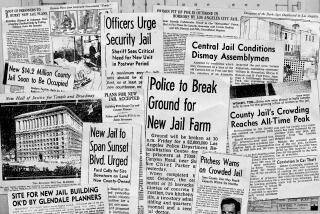JUSTICE 101 : A COURTROOM PRIMER
- Share via
Smith, Broderick, Bobbit, and soon, live from Los Angeles, Menendez II and Simpson. A stream of televised, high profile trials over the past few years has brought the courtroom into the living room. Some viewers might grow bored as the cases bog down in the minutiae of real-world legal procedures.
So, let’s pause for a brief civics lesson, and to consider the thousands of other cases that move through the courts of Los Angeles each year. Even without the glare of publicity, each follows the same tortuous path, often at a snail’s pace.
The wheels of justice turn slowly for a reason. Although each case is different, bringing with it varying factual circumstances and legal issues, every criminal case follows certain steps. A simple case usually takes from six months to a year; a complex case can take years. This is especially true of murder cases in which the death penalty is sought.
The Simpson case, in comparison, can be said to be moving at the speed of light.
A Criminal Case Goes To Trial
1) FILING or INDICTMENT: Police may arrest someone on suspicion of committing a crime, but only the district attorney or city attorney can file charges. The district attorney handles felonies, the city attorney misdemeanors. In some cases, prosecutors use the grand jury, which has the power to subpoena witnesses. If the grand jury issues an indictment, the case heads directly to Superior Court.
2) ARRAIGNMENT: The arraignment, or formal reading of the charges, occurs before a Municipal Court judge. The exception is grand jury cases, which bypass Municipal Court. Suspects must be arraigned within 48 hours of arrest, or within 72 hours if the arrest occurs over the weekend.
3) PRELIMINARY HEARING: The hearing is a mini-trial to determine whether the prosecution has brought enough evidence to show that a crime occurred and that the defendant probably committed it. If the Municipal Court judge agrees such evidence exists, the defendant is “bound over” for Superior Court trial. A defendant is entitled to the hearing within 10 days of arraignment, but it is usually postponed with the defendant’s consent, known as “waiving time.”
4) PLEA NEGOTIATIONS: Some charges are usually dismissed in exchange for the plea to other counts. Prosecutors and defense attorneys generally agree on the sentence, but their arrangement is not binding on a judge. After the plea, the probation department prepares a background report on the defendant and recommends a sentence. The judge is not bound by that report, either. The sentence can vary on a number of variables, including the seriousness of the crime and the defendant’s history of past crimes.
5) SUPERIOR COURT: The journey through Superior Court again begins with an arraignment. A defendant has the right to a trial within 60 days, but most agree to “waive time.” If a defendant pleads guilty or “no contest,” a sentencing date is set. If the plea is not guilty, the judge will schedule dates to hear various legal motions, usually filed by the defense. The motions can challenge, for example, whether police obtained evidence legally.
6) TRIAL: There are two types of trials. A trial by a judge, sitting without a jury, is known as a “bench” or “court” trial. Most defendants opt for trial by jury. Each lawyer is given a certain number of “preemptory challenges,” which they can use to strike a juror without explanation. After 12 jurors are chosen, two to six alternate jurors are chosen.
Trial Issues
* BURDEN OF PROOF: Because defendants are presumed innocent, the prosecution has the burden of proof and presents its evidence first. If the case continues, the defense may present witnesses. The defendant is under no obligation to testify, and jurors are instructed not to consider it if he doesn’t.
* VERDICT: If the jurors can’t agree on a verdict, a mistrial is declared and prosecutors will decide whether to retry the case or dismiss the charges. If the defendant is found guilty, a sentencing report is prepared by a probation officer and the judge imposes sentence, usually within three months after the verdict. The verdict may be appealed.
Tough Sentences
California’s state prison population is about 125,319. More than a third of them were sentenced in Los Angeles County.
As of Aug. 1, 1994:
Los Angeles County - 37.3%
San Diego County - 8%
Orange County - 4.9%
Santa Barbara County - 4.9%
Sacramento County - 4.2%
Volume of Cases
Los Angeles, Orange and Ventura counties account for a third of all criminal cases and civil lawsuits filed in California.
1992-93
State Total: 1,017,798
Los Angeles County: 291,203
Orange County: 77,136
Ventura County: 21,311
Judicial Burden
Cases per judge in Los Angeles, Orange and Ventura counties are about the same, but in sprawling Los Angeles County many more judges share the load.
Fiscal 1992
State total
Number of Judicial Positions: 928
Number of cases Per Position: 113
*
Los Angeles County
Number of Judicial Positions: 295
Number of cases Per Position: 161
*
Orange County
Number of Judicial Positions: 71
Number of cases Per Position: 157
*
Ventura County
Number of Judicial Positions: 16
Number of cases Per Position: 164
Pleading Guilty
Nearly all criminal cases are resolved by guilty pleas. Only a small percentage of cases actually result in trials. Percent pleading guilty:
Statewide Total: 79.3%
Los Angeles County: 68.5%
Orange County: 92.1%
Ventura County: 87.5%
*
Judge Robert M. Letteau, supervising judge for the Van Nuys branch of the Los Angeles County Superior Court, says the 23 Van Nuys and 16 San Fernando judges are experimenting with ways to make the cases flow more smoothly. They fill for each other, and some Superior Court judges have agreed to take felony pleas in Municipal Court, clearing many cases before they can become backlogged. According to Letteau, there are about 65 cases outstanding per judicial position. The two courts have shared space since the San Fernando Courthouse was damaged in the Jan. 17 earthquake.
“We’re getting the work done. I think we’re processing the cases as efficiently as we can.”
-Robert M. Letteau
Sources: Los Angeles County district attorney’s office; Judicial Council of California; California Department of Correction; Researched by ANN O’NEILL / Los Angeles Times
More to Read
Sign up for Essential California
The most important California stories and recommendations in your inbox every morning.
You may occasionally receive promotional content from the Los Angeles Times.










